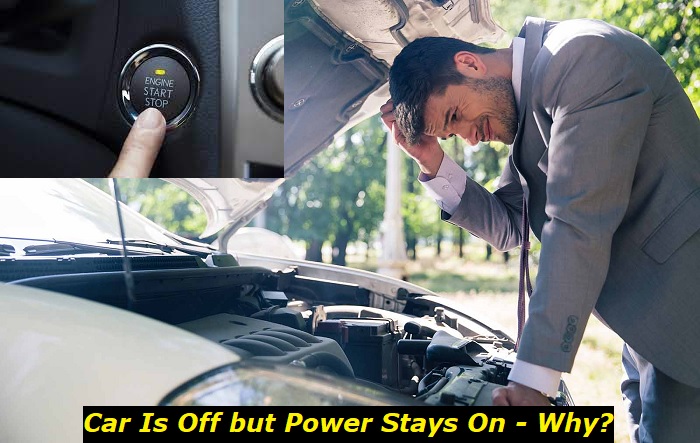The potential cause of the power-on problems can be carbon buildup, a defect in the electrical system, or "dieseling". You should examine the ignition or stop/start button, spark plugs, fuel system, engine, power relay, battery, alternator, etc. Check the vehicle's ignition timing, idle speed, and so on as well.
Electrical circuit problems highlights
- Level of urgency:high
- DIY inspection:possible but very complicated
- DIY repair:mostly impossible
- Can you drive?yes
- Price for repairs:$150 - $350
- Symptoms:all kinds of different symptoms with all possible equipment
- Ways to solve:diagnose wiring and connections, inspect electrical equipment

When Your Car Refuses To Go Off
It's most likely that your ignition and fuel systems aren't responding to the deactivation commands. And an electrical issue may be the most likely culprit. Be prepared for a potential ignition switch or power relay replacement in this case.
There could also be the case of the engine showing possible signs of dieseling. It may refuse to stop while experiencing "leaping convulsions". This may be followed by pinging and knocking sounds.
Dieseling happens when there's something in the engine's combustion chamber that's heated enough to ignite any residual fuel that goes into the system. It's referred to as dieseling because diesel engines light up their fuel (diesel) using the same method. Electrically charged spark plugs aren't utilized.
Recent model-year fuel-injected cars don't usually experience dieseling. But it's a problem that owners of old model-year vehicles that use carburetors have a high chance of facing.
Step 1: Checking for an Electrical Problem
1) Necessary Equipment
- Vehicle owner's manual
- Screwdrivers (straight and Phillips)
2) Looking at the Symptoms
You have to check for a few conditions to confirm whether it's a dieseling or electrical problem. The questions that you'll be trying to answer include the following:
- Does it feel as if you haven't switched off the ignition when you turn it off with the key?
- Are the accessories, instruments, and turn signals still functioning after you try to switch the ignition off?
- Is the engine running normally as if you could put the car in gear and drive off?
It should be seen as an electrical problem if the answer to each of the above questions is "yes". But check step 2 to understand what's going on with the vehicle if the engine starts making pinging and knocking sounds or turns without shutting off totally.
3) Confirming the Need To Replace the Ignition Switch
Proceed to find the electrical connector to the switch by removing the bottom half of the plastic covering that surrounds the steering column. The connector may be positioned behind the switch. It may also be at the end of an electrical pigtail from the ignition switch and be situated farther down the steering column.
Unplug the ignition switch at its electrical connector to see if the power will go off. If so, then the electrical issue will have to be resolved by swapping out the ignition switch parts. If not, then proceed to examine the power relay.
4) Confirming the Need To Replace the Power Relay
Find the main relay for the ignition and fuel systems. The vehicle owner's manual should guide you in this search. The main relay may be referred to as the electronic control module (ECM) relay, electronic control unit (ECU) relay, Digifant control relay, or DME (digital motor electronics) relay in some car manuals.
Your vehicle may be receiving power abnormally because of a sticking main relay. So try to remove the relay to confirm this. Swap it out if the vehicle's power goes out after its removal.
Step 2: Checking for Dieseling
1) Necessary Equipment
- Vehicle owner's manual
- Screwdrivers
- Safety glasses
- Vehicle-compatible distributor wrench
- Vehicle-compatible spark plug wrench
- Timing light
- Tachometer
2) Ascertaining If Your Car Is Fuel-Injected or Features a Carburetor
Check the vehicle owner's manual for this. There'll be a good chance of the car being fuel-injected if it was manufactured after the first half of the 80s.
Dieseling isn't usually an issue in fuel injection systems due to the fuel supply being closed off immediately after the switch is turned off. A carburetor will keep supplying fuel if air continues to go through it.
3) Confirming the Need To Replace the Fuel Injector
Based on what we have stated about dieseling so far, you should have an idea of what you're looking for at this stage. A vehicle that has a fuel injection system is experiencing dieseling when a fuel injector is leaky. The defective injector should be swapped out for dieseling to cease.
4) Confirming the Need To Adjust the Idle Speed
A high idle speed may result in dieseling if the vehicle is switched off. Confirm this by hooking up your tachometer to the vehicle in line with the guidelines of usage. Six-cylinder engines are supposed to be idling at 859-900 RPMs, while eight-cylinder engines should be doing so at a rate of about 600 RPMs.
Use the vehicle owner's manual to verify the right idle speed range of the car's engine. Adjust the idle speed to be within the specified range.
5) Confirming the Need To Replace the Anti-Dieseling Solenoid
Dieseling began to become an issue even on new vehicles after the inclusion of emission controls in the late 70s. So car makers introduced an electrical shut-off valve in their carburetors, referring to it as an anti-dieseling solenoid.
This component is typically cylindrical with a length of 1 to 2 inches. It also features a wire/cable connection. The cable gets heated when the ignition is on and it triggers the valve's opening. It will only let the valve close when the ignition is off.
Unplug the wire and switch on the ignition, then make the connectors touch and release them. A click should be heard whenever the solenoid opens or closes. So you can be sure that the solenoid is failing if no click is heard. The solution is to replace this part.
6) Confirming the Need To Adjust the Ignition Timing
Recent-year model cars don't feature adjustable ignition timing, but yours could have it if the vehicle is an old model. Check to see if the ignition timing isn't at the specified rate. This is because the timing being off by a few degrees could lead to a rise in engine temperature and create the conditions for dieseling.
Make reference to the vehicle owner's manual for the correct timing procedure. It varies from vehicle to vehicle. Your car may require the timing to be set at idle or at a high RPM. Some vehicle manuals would require the disconnection of some controls before the timing is set. There's no generic process for all engines.
You have to be cautious during this process because you'll be doing it near moving (rotating) engine parts. Let the timing light illuminate the timing marks as the engine is running at the required RPM. Then confirm that the marks line up correctly.
Adjust the timing if it's not appropriate. Do so by loosening the distributor with a compatible wrench and turning it a little to whichever direction you intend.
7) Confirming the Need To Change the Spark Plugs
Utilizing an incompatible spark plug can lead to dieseling. Such components are designed to sustain a particular working temperature. So the spark plugs may bring about hot spotting which can cause dieseling when they have incorrect heat ranges.
Step 3: Checking for Carbon Buildup
1) Necessary Equipment
- Premium gas
- Engine cleaning fuel additive
Carbon buildup can heighten engine compression and result in hot spotting in the combustion chamber. This will bring about dieseling, but you can use fuel additives or premium gas to deal with the accumulation of carbon.
2) Applying Fuel Additives
Fuel additives are typically applied by pouring the fluid into your fuel tank when it's filled up. Then you should proceed to drive the car on the highway while performing some hard accelerations. The additive will aid in breaking up carbon deposits and getting rid of them through the exhaust pipe.
Note: Don't pour water down your carburetor to clear carbon deposits or it will ruin your engine.
3) Changing Your Fuel
Utilize a higher octane fuel to prevent dieseling. Such fuel types have more stability and low susceptibility to the pre-ignition that's triggered by the accumulated carbon.
Conclusion
For the last part under "changing your fuel", you may not be able to keep up with the higher cost of using premium gas. Such a fuel type may handle the carbon buildup initially, but its effectiveness will dwindle as time passes. The best way to deal with dieseling is to perform a major engine fix!
About the authors
The CarAraC research team is composed of seasoned auto mechanics and automotive industry professionals, including individuals with advanced degrees and certifications in their field. Our team members boast prestigious credentials, reflecting their extensive knowledge and skills. These qualifications include: IMI: Institute of the Motor Industry, ASE-Certified Master Automobile Technicians; Coventry University, Graduate of MA in Automotive Journalism; Politecnico di Torino, Italy, MS Automotive Engineering; Ss. Cyril and Methodius University in Skopje, Mechanical University in Skopje; TOC Automotive College; DHA Suffa University, Department of Mechanical Engineering






Add comment